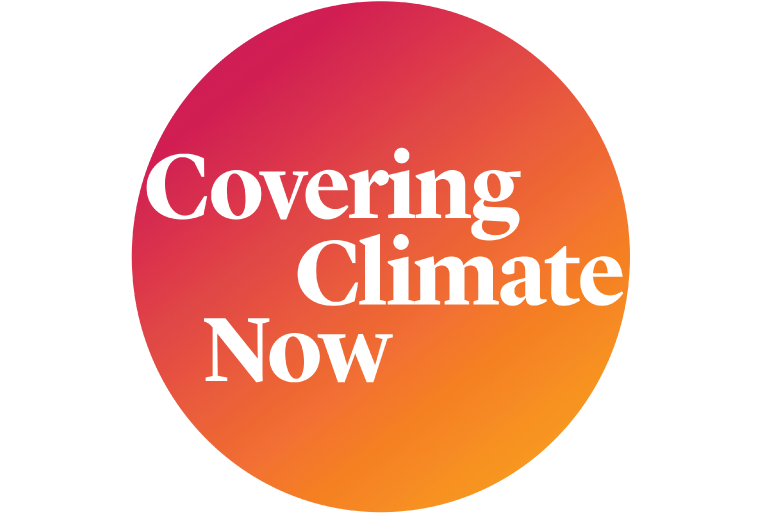Sign up for the daily CJR newsletter.
At the end of April, CJR and The Nation announced plans for a new initiative to dramatically improve the media’s coverage of the most urgent story of our time. Since then, interest in our Covering Climate Now project has been enormous. To answer questions about it, and to outline how news outlets across the country can get involved, here’s a primer on the project and on where it goes next.
Who are we?
We are journalists, talking and working with fellow journalists, to transform our profession’s coverage of climate change. Whether you work in television or audio, print or online, for a local, regional, national, or international outlet, climate change touches every beat in every newsroom. And at this late hour, we need journalism everywhere to treat this story with the urgency that science demands.
CJR and The Nation are leading this effort, along with partners such as The Guardian and others yet to be announced. On behalf of the Schumann Media Center, Bill Moyers pledged $1 million to support the initiative for its first year.
What are we doing?
We see ourselves as convening and informing a conversation that journalists need to have, with each other and the public we serve, about how to do justice to the climate story at this decisive historic moment. To succeed, we need the participation and energy of as many journalists and news outlets as possible. We also need to hear from a wide range of stakeholders—scientists, advocates, government and business officials, and private citizens—about how we can do a better job of making clear what is happening, why, and what can be done about it.
We aim to bring journalists together face to face—as we did at a conference at the Columbia Journalism School in April that launched this effort, and in additional gatherings planned across the United States and abroad—and online, via a new vertical housed on the websites of CJR and The Nation. In these and other venues, we hope that journalists and others will talk about, report on, analyze, and debate how news outlets should cover the rapidly uncoiling climate crisis and its solutions.
We want to highlight the good coverage that’s being done (there’s lots of it) and find ways to encourage more of it. We want to figure out how to persuade newsroom managers that covering the climate crisis is our journalistic responsibility and also need not lose money. (The data may surprise you.) Given the current economics of journalism, we know the answer can’t require tons more newsroom resources. It can, though, involve smarter use of the resources we have, as well as integrating the climate story into everything we do.
We want to share ways of telling the climate story that draw in viewers and readers and empower them to take action. We’re as much about solutions to the problem as we are about detailing the problem itself. Above all, we want to break the climate silence that still pervades too much of the news media.
A focused week of coverage
We’ll work to organize as much of the news media as possible—large and small, national and local—to commit to one week of focused coverage of climate change this September. The Secretary-General of the United Nations, António Guterres, is convening a summit in New York on September 23, where nations are urged to show how they will limit global temperature rise to 1.5 degrees Celsius. We propose a week of concentrated climate coverage in the lead-up to the UN summit, beginning September 16.
We believe that every news organization in America, and many around the world, can play a part. Sometimes that will mean committing your newsroom to important and high-impact stories. Other times it will mean sharing your content, engaging your community, or adding a few lines of climate information to stories that wouldn’t otherwise have them. The answer lies in your creativity and participation.
We can only do these things if a critical mass of journalists and news outlets come together to talk about how to make them happen, and if our work is informed by engagement with everyone who cares about this problem.
That’s where you come in. How this conversation unfolds and ultimately affects overall media coverage of the climate crisis depends on who gets involved and how well we all rise to the challenge.
Ongoing newsroom support
We see the week of focused coverage not as an end in itself, but as the beginning of the work to transform how newsrooms conceive of their climate coverage.
To help them in that effort, we will provide substantial resource guides for journalists, tutorials, source lists, and web briefings; we’ll gather the best of climate coverage in an online blog, and provide commentary on how other reporters can replicate it; and we will increase our own reporting on how news outlets are covering the climate crisis, highlighting what is working and calling out what isn’t.
In the most dramatic cases, we’ll deploy Rapid Response Teams to newsrooms tasked with covering extreme weather or disaster in their own backyards. In those cases, we’ll assist newsrooms, either in person or remotely, with additional reporting help as well as whatever scientific or other resources are needed for them to fully tell their story.
How can you get involved?
Send us an email. Tell us who you are and why you want to be part of this. We’ll post a running list of the people and organizations that have signed on, along with contact information.
If you are a journalist, here’s what we’re looking for: Can you and your news outlet sign as a partners of Covering Climate Now, and build the network by encouraging others to do the same? Can you commit to the week of focused climate coverage in September? Can you share your climate content with other outlets that may lack your resources? Can you help us organize a conference on covering climate change in your region, and encourage your media counterparts to join us?
If you are a scientist, will you be a resource journalists can call when reporting a climate story? Will you share your expertise with Covering Climate Now as we prepare our briefing materials for journalists on the climate beat? Will you appear at any of the conferences we will be organizing in media markets around the country and abroad? Will you urge other scientists to join these efforts?
If you are an advocate or a government or business official, will you be a resource for journalists reporting a climate story? Will you share your observations for our handbook? Will you appear at any of the conferences we will be organizing, and spread the word about our efforts?
If you’re a private citizen, will you work with your local news outlet to think through how to improve their climate coverage, and organize other people in your community to do the same?
What makes us different?
We see ourselves as a gathering place for journalists and others who care about the media’s coverage of the climate crisis. There are numerous groups and individuals who’ve been working for years now to improve media coverage of climate change, and we look forward to collaborating with them. We don’t want to reinvent the wheel. There is no substitute, however, for journalists themselves talking and working together to chart a better course.
Want more information?
Please contact:
- Mark Hertsgaard, the environment correspondent for The Nation and the author of Earth Odyssey, has covered climate change in the US and around the world since 1989. He’s reachable at mark@markhertsgaard.com or 415-923-8983.
- Kyle Pope, editor and publisher of Columbia Journalism Review. He’s reachable at kpope@cjr.org or 212-854-7004.
RELATED: The media are complacent while the world burns
Has America ever needed a media defender more than now? Help us by joining CJR today.









